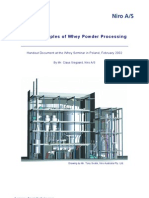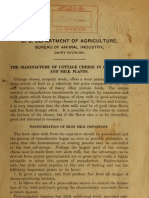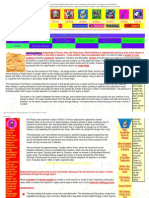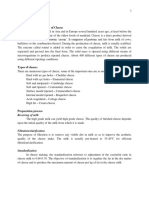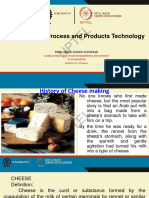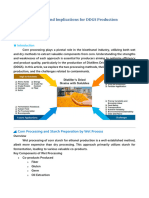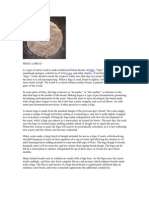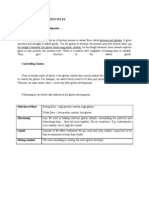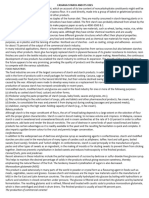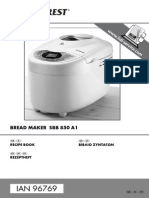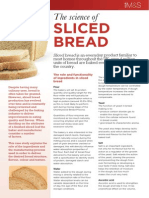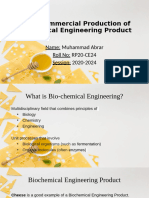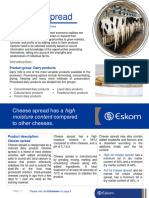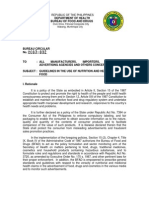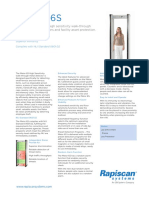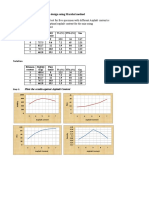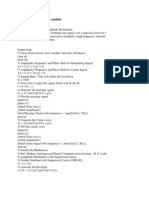Cheese Technology
Cheese Technology
Uploaded by
Bun SpyCopyright:
Available Formats
Cheese Technology
Cheese Technology
Uploaded by
Bun SpyOriginal Description:
Copyright
Available Formats
Share this document
Did you find this document useful?
Is this content inappropriate?
Copyright:
Available Formats
Cheese Technology
Cheese Technology
Uploaded by
Bun SpyCopyright:
Available Formats
ANSC 137 CHEESE TECHNOLOGY EXERCISE 4 GOUDA CHEESE
INTRODUCTION Gouda is one of the semi-hard washed cheeses, the largest and most diverse group of cheese which include Edam, Colby, Brick, Montasio, Oka, Menster and many others[1]. The distinguishing feature of these cheeses is the practice of washing to remove lactose. Part or all of the whey is removed and replaced with water to leach lactose from the curd to limit its amount to a level which permits sufficient lactic acid development to produce a minimum pH of 5.0 - 5.2, but not enough to ferment and produce cheese pH less than 5.0[1]. The amount of syneresis is controlled mainly by the temperature, cooking time, and by the temperature of wash water as higher temperatures cause the curd to contract and expel moisture. The curd is then placed in round molds which give its traditional wheel-like shape[2]. Gouda was named after the Dutch city of Gouda in the province of Zuid-Holland. In spite of that, the Gouda cheese with the highest regard comes from Noord-Holland the Noord-Hollandse Gouda which is registered in the EU as a Protected Designation of Origin[3]. Unless with this name combination however, Gouda is a generic cheese describing the type and flavor of the cheese rather than its place of origin, and hence can be made anywhere in the world[3]. Gouda is good as a table cheese and for snacks and grilling. Aged Gouda can be grated over baked potatoes or included in potatoes au gratin. It goes particularly well with good bread and any type of wine or beer. Gouda is a breakfast staple in Europe, eaten with fresh fruit. OBJECTIVE To acquaint the students with the procedures in Gouda cheesemaking from whole milk and as a result, be able to make Gouda cheese.
METHODS AND MATERIALS Materials: Cows milk, 10kg Lactic starter Rennet Brine, 20% salt Thermometer Casserole Ladle Cheese mold Cheese cloth 10-kg weight to press Methods: Cows milk was pasteurized at 72C for 15 seconds and cooled down to 30C. Lactic starter culture was added at 1.5% and left to stand for 30 minutes. Rennet was added based on a PRV of 200 and allowed to coagulate for 25 minutes. The coagulum was cut into approximately inch cubes and left undisturbed for 15 minutes. Afterwhich, about 1/3 of whey was drained while stirring continuously for 5 minutes. The drained whey was replaced with hot water at 65C maintaining the temperature at 38C. The washed curd was stirred continuously for another 30 minutes with some of the whey, then placed in a cheesecloth-lined mold and pressed with a 10-kg weight removing the whey. The pressed cheese block was inverted and pressed again, leaving overnight to fully drain. In refrigerator, it was soaked after in 20% brine for four hours, dried overnight at the same temperature, waxed and left to ripen for 2 to 3 months at about 15C. RESULTS AND DISCUSSION The resulting yield at 10% was the lowest of all the previous cheeses made owing to pressing which is characteristic of its process, the product being a semi-hard cheese. Consequently, the production cost at P39.00/100-gram is relatively higher than cream cheese at 15%, than Feta at 63%, and than Ricotta at 42%
Product Costing
CONCLUSION The exercise clearly differentiated Gouda from previous cheeses made with its curd being washed, and introduced processing ripened cheeses with pressing to attain compactness, and waxing to protect the cheese from mold contamination and loss of moisture and possible flavor loss. REFERENCES [1] 2012, Dairy Science and Technology, Cheese Technology, University of Guelph, Canada [2] 2012, Gouda Cheese: Nutritional Facts and General Information, www.professorshouse.com [3] 2007, The History of Gouda Cheese, ReadAbout.com.au
You might also like
- Whey Powder ProcessingDocument13 pagesWhey Powder Processinghozhabr100% (1)
- Cookie FormulationDocument11 pagesCookie Formulationnaspterboy100% (4)
- 1kw Sine Wave Inverter Circuit Diagram PDFDocument10 pages1kw Sine Wave Inverter Circuit Diagram PDFAndone Anutu100% (1)
- Cheese GoudaDocument24 pagesCheese GoudaJhon Jairo ZambranoNo ratings yet
- Making Cottage CheeseDocument4 pagesMaking Cottage CheeseKathryn Bax100% (1)
- Steps Involved in Cheese MakingDocument2 pagesSteps Involved in Cheese MakingArunkumar KPNo ratings yet
- Cheese MakingDocument19 pagesCheese MakingPoulami DeNo ratings yet
- 48997019fff FNB Cheese AssignmentDocument27 pages48997019fff FNB Cheese AssignmentNicoleta Mihaela BuzaNo ratings yet
- cheeseprocessingDocument27 pagescheeseprocessingAKSHAYA LAKSHMI S N-04No ratings yet
- Cheese PlantDocument11 pagesCheese PlantAnkit PaliwalNo ratings yet
- Baking UpdateDocument2 pagesBaking UpdateAchyut TripathiNo ratings yet
- W12 - Module 010 Preparation of Pastry ProductsDocument22 pagesW12 - Module 010 Preparation of Pastry ProductsRonalyn C. CariasNo ratings yet
- Pastry Puff MakingDocument80 pagesPastry Puff MakingYip AlexNo ratings yet
- CheeseDocument81 pagesCheesemmkharatNo ratings yet
- Thesis On Bread MakingDocument7 pagesThesis On Bread MakingJill Brown100% (2)
- The Chemistry of BakingDocument8 pagesThe Chemistry of BakingmajikNo ratings yet
- Cassava Starch and Its UsesDocument15 pagesCassava Starch and Its UsesQueennie Legaste100% (1)
- Bake+Info Info Danish+PastriesDocument3 pagesBake+Info Info Danish+PastriesokosNo ratings yet
- Production of Soft CheeseDocument13 pagesProduction of Soft CheeseRose YacobNo ratings yet
- BreadDocument5 pagesBreadAisha JananNo ratings yet
- 15871822311FSTSE0601 ChemistryAndTechnologyOfCheeseDocument6 pages15871822311FSTSE0601 ChemistryAndTechnologyOfCheesechemeng1No ratings yet
- Cheese FMTDocument7 pagesCheese FMTdonvickmillNo ratings yet
- Organic Cake: Moringa Oleifera Flour As New Ingredient Source in MakingDocument20 pagesOrganic Cake: Moringa Oleifera Flour As New Ingredient Source in MakingapekjrNo ratings yet
- Week 11Document57 pagesWeek 11ShashankShethNo ratings yet
- Methods and Implications For DDGS ProductionDocument7 pagesMethods and Implications For DDGS Productionabuahbau2017No ratings yet
- Bread AloneDocument22 pagesBread Aloneafaque ahmedNo ratings yet
- What Is BigaDocument7 pagesWhat Is BigaFar LaughNo ratings yet
- BSE 461 Cheese ProductionDocument40 pagesBSE 461 Cheese ProductionLizzie RungeNo ratings yet
- Microbiology of Concentrated MilkDocument30 pagesMicrobiology of Concentrated MilkNitric AcidNo ratings yet
- Information Sheet: Danish PastriesDocument3 pagesInformation Sheet: Danish Pastriesdefa rey100% (1)
- Bakery Notes TheroyDocument39 pagesBakery Notes TheroySunil Kumar100% (8)
- Week 2: Baking Principles: Mixing and Gluten DevelopmentDocument7 pagesWeek 2: Baking Principles: Mixing and Gluten DevelopmentAhmad Jalalluddin MuhanaffNo ratings yet
- Cassava Starch and Its UsesDocument9 pagesCassava Starch and Its UsesGabriel OnalekeNo ratings yet
- Microbiology of Concentrated MilkDocument31 pagesMicrobiology of Concentrated Milkkumarrishi02101999No ratings yet
- Biscuit Making ProcessDocument9 pagesBiscuit Making ProcessesraNo ratings yet
- M2 - Flour and The Gluten ProcessDocument32 pagesM2 - Flour and The Gluten ProcessJennifer Roxas21No ratings yet
- en EL RezeptheftDocument38 pagesen EL RezeptheftNatassa MavropoulouNo ratings yet
- Cheese Production: by Primrose Katsande and Chipo ParaffinDocument17 pagesCheese Production: by Primrose Katsande and Chipo Paraffinmatthew matawoNo ratings yet
- Maam NotesDocument86 pagesMaam NotesPranay MeskarNo ratings yet
- Cheese MakingDocument9 pagesCheese MakingRiantyNo ratings yet
- Manufacturing Process of Food Grade PastriesDocument20 pagesManufacturing Process of Food Grade PastriesMuneeb0% (1)
- Cheesemaker: ProcessDocument4 pagesCheesemaker: Processmichol2014No ratings yet
- CheeseDocument60 pagesCheeseshivkumar100% (3)
- Compilation of Modules and Activities: Submitted ToDocument36 pagesCompilation of Modules and Activities: Submitted ToLogatic Marian JoyNo ratings yet
- Module 1 Glossary TermsDocument6 pagesModule 1 Glossary Termsrheasa99No ratings yet
- BCL ManualDocument23 pagesBCL ManualrajaNo ratings yet
- Prepare & Produce Bakery, Pastry & Cakes ProductsDocument198 pagesPrepare & Produce Bakery, Pastry & Cakes ProductsBong Lacaden94% (48)
- Sliced Bread: The Science ofDocument4 pagesSliced Bread: The Science ofGayatri PrameswariNo ratings yet
- Food and Nutrtionss2 1Document12 pagesFood and Nutrtionss2 1onyinyejustina545No ratings yet
- Biochemical Engineering PresentationDocument18 pagesBiochemical Engineering PresentationMuhammad Abrar RP20-CE25No ratings yet
- The Baking and Frozen Dough MarketDocument4 pagesThe Baking and Frozen Dough MarketMilling and Grain magazineNo ratings yet
- Pastry, Cakes and CookiesDocument9 pagesPastry, Cakes and CookiesMheg Sophia HockkinsNo ratings yet
- Cheese Manufacturing ProcessDocument8 pagesCheese Manufacturing ProcessBenzene100% (1)
- Bio - Fermented Project (Cheese)Document3 pagesBio - Fermented Project (Cheese)Emily ZhenNo ratings yet
- Production & Downstream Processing of Baker's Best FriendDocument26 pagesProduction & Downstream Processing of Baker's Best FriendMelissaNo ratings yet
- CheesemakingDocument2 pagesCheesemakingsyifa salsabilaNo ratings yet
- Cheese SpreadDocument6 pagesCheese Spreadmido81No ratings yet
- 24-Cheese Making-13-02-2023Document19 pages24-Cheese Making-13-02-2023Sarwin BalajiNo ratings yet
- Discuss Application of The Agitation & Removal of Contaminants. Explain Advantages and Disadvantages of EachDocument1 pageDiscuss Application of The Agitation & Removal of Contaminants. Explain Advantages and Disadvantages of EachBun SpyNo ratings yet
- Provisional Permit To MarketDocument2 pagesProvisional Permit To MarketBun SpyNo ratings yet
- Permissible Net ContentsDocument1 pagePermissible Net ContentsBun SpyNo ratings yet
- Nutrition&Health ClaimDocument7 pagesNutrition&Health ClaimBun SpyNo ratings yet
- Monitoring of Food Products Requiring An Open Date MarkingDocument1 pageMonitoring of Food Products Requiring An Open Date MarkingBun SpyNo ratings yet
- Micronutrient FortificationDocument13 pagesMicronutrient FortificationBun SpyNo ratings yet
- FDA Lettre Pip Juin 2000Document5 pagesFDA Lettre Pip Juin 2000d_bemeNo ratings yet
- DM CMVU720 N InstallationDocument160 pagesDM CMVU720 N Installationdomi1803No ratings yet
- Divorce Part3Document7 pagesDivorce Part3Chamela MahiepalaNo ratings yet
- PowerStore ESSMDocument26 pagesPowerStore ESSMbilashsNo ratings yet
- 5 Investment Books For 2021Document4 pages5 Investment Books For 2021Yassine MafraxNo ratings yet
- 02 DATASHEET - Metor 6S PDFDocument2 pages02 DATASHEET - Metor 6S PDFSaurabh TrivediNo ratings yet
- 1315ue 2025-05Document68 pages1315ue 2025-05Hùng Hoàng DuyNo ratings yet
- Hercules 6 User ManualDocument24 pagesHercules 6 User ManualAlexandre de OliveiraNo ratings yet
- 21project Charter Template 011Document18 pages21project Charter Template 011sunilkhairnar38No ratings yet
- Marshal HMA Mixture Design ExampleDocument2 pagesMarshal HMA Mixture Design ExampleTewodros TadesseNo ratings yet
- Maldives Paradise Island Resort CompressedDocument1 pageMaldives Paradise Island Resort Compressedhan chuk banNo ratings yet
- 250 MR Excel Keyboard ShortcutsDocument17 pages250 MR Excel Keyboard ShortcutsNam Duy Vu100% (1)
- Catalogo Peças 4428-4430 TRATOR COYOTE 2 3 4 CILINDROSDocument26 pagesCatalogo Peças 4428-4430 TRATOR COYOTE 2 3 4 CILINDROSretificateixeiraNo ratings yet
- Measures of Fit For Logistic Regression: Paul D. Allison, Statistical Horizons LLC and The University of PennsylvaniaDocument12 pagesMeasures of Fit For Logistic Regression: Paul D. Allison, Statistical Horizons LLC and The University of Pennsylvaniajiregna eticha dakoNo ratings yet
- IBM Power E1080 Level 2 Quiz - Attempt ReviewDocument13 pagesIBM Power E1080 Level 2 Quiz - Attempt ReviewAlain Batikbonak-Tukum100% (2)
- Kenwood TS-130S - V Instruction ManualDocument30 pagesKenwood TS-130S - V Instruction ManualJim AldousNo ratings yet
- Generator ProtectionDocument24 pagesGenerator ProtectionSantoshkumar Gupta100% (2)
- Product Datasheet Product Datasheet DST MITW 20 W/2700 K 220 240 V E27Document3 pagesProduct Datasheet Product Datasheet DST MITW 20 W/2700 K 220 240 V E27Lucas GiacomelliNo ratings yet
- Manual Fx2n 485 BDDocument8 pagesManual Fx2n 485 BDaxo_vfrNo ratings yet
- Paren PatriaeDocument2 pagesParen PatriaeMichael Muhammad100% (1)
- Sample Research Proposal On ICTDocument1 pageSample Research Proposal On ICTLiza Laith LizzethNo ratings yet
- Magnetic Effects of Current and Magnetism PDFDocument65 pagesMagnetic Effects of Current and Magnetism PDFRadha SundarNo ratings yet
- Matlab Code ExampleDocument4 pagesMatlab Code Exampleabhishekbhatt_iitrNo ratings yet
- Joint Affidavit NEW (One and The Same) - GanhinhinDocument2 pagesJoint Affidavit NEW (One and The Same) - GanhinhinErica Mae SimilNo ratings yet
- Warren BuffettDocument9 pagesWarren BuffettyogaharisNo ratings yet
- ASSET Planning Guide (GSM)Document31 pagesASSET Planning Guide (GSM)វុធ រតនាNo ratings yet
- C-12 CS PB-IDocument9 pagesC-12 CS PB-IAshutosh TripathiNo ratings yet
- D1, D2, D3 Paper 2 AnswersDocument82 pagesD1, D2, D3 Paper 2 AnswersRacoNo ratings yet
- TerracottaDocument11 pagesTerracottaDiaszNo ratings yet
